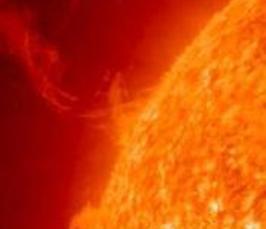ESPOS Seminar: Small-scale MHD waves in the solar chromosphere with ALMA (Juan Camilo Guevara Gómez)
ESPOS
- Date: Mar 17, 2022
- Time: 11:00 AM c.t. - 12:00 PM (Local Time Germany)
- Speaker: Juan Camilo Guevara Gómez
- Rosseland Centre for Solar Physics, University of Oslo, Norway
- Location: Max Planck Institute for Solar System Research (live)
- Room: Zoom
- Host: Shahin Jafarzadeh

Magnetohydrodynamic (MHD) waves are thought to be one of the key mechanisms for transferring energy and momentum through the Sun’s atmosphere, hence maintaining the temperature profile of the outer atmospheric layers. Here, we have studied small-scale chromospheric bright features, exhibiting oscillations in brightness temperature, size, and horizontal velocity, in Bands 3 (∼3 mm) and 6 (∼1.2 mm) of 2 seconds cadence solar observations with ALMA, as well as in associated synthetic lines from a Bifrost simulation, degraded to match the ALMA’s spatial and temporal resolutions. In total, 486 and 235 features were analysed in the observations and simulations, respectively. Periods of the oscillations and phase angles between the perturbations in any of the two parameters were characterised by means of wavelet analysis. As a result, median periods were obtained for the oscillations on the order of 90 s (Band 3) and 64 s (Band 6) for brightness temperature, 82 s (Band 3) and 56 s (Band 6) for size and, 65 s (Band 3) and 52 s (Band 6) for horizontal velocity. Phase relations between the high-frequency oscillations in brightness temperature and size suggest the presence of fast and slow MHD sausage modes in the small magnetic structures. In addition, the high-frequency fluctuations in transverse displacement are likely Alfvénic and can be representative of MHD kink mode. Furthermore, we have compared the outcomes between the two ALMA frequency bands as they are considered to be formed at distinct heights in the solar chromosphere and have used the simulations to discuss the context of the observational results. Finally, this study confirms the diagnostic potential of solar ALMA observations with very good cadence and resolution, as well as their essential role as complementary with respect to other diagnostics.